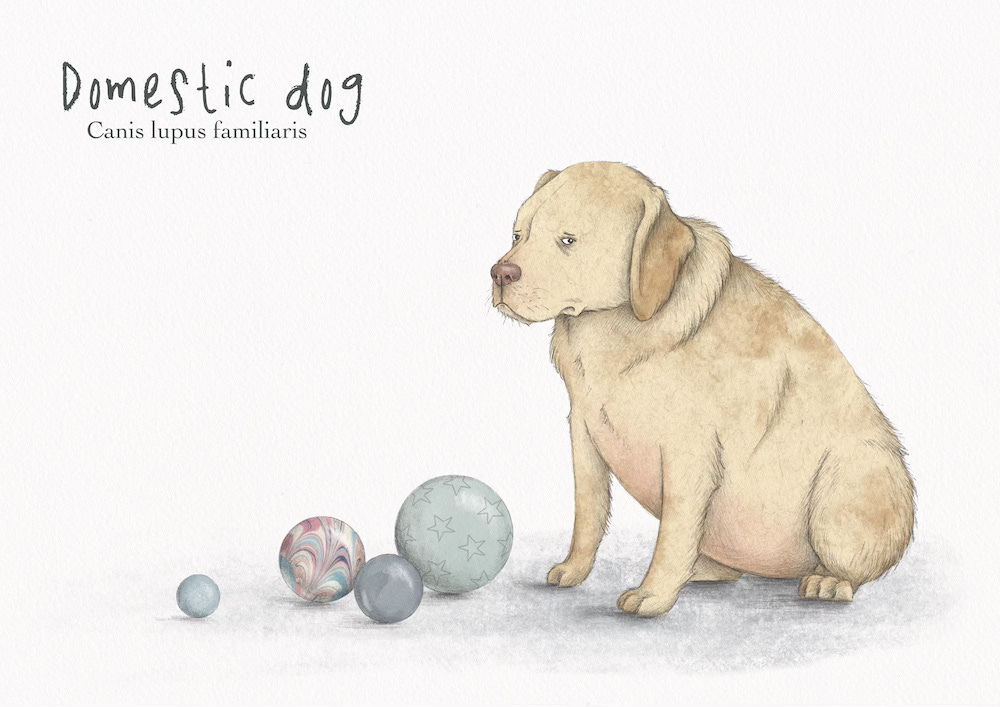In addition to my semi-regular ramblings about art angst, once a month I’ll be focusing on a different animal that I have encountered. From tiny insects, to enormous whales. Many brushes with nature have left a lasting impression. This month I’m looking at the Labrador retriever.
Wait, a Labrador? I told you I’d be writing about my encounters with wildlife and sharing a little natural history of the animals I’ve met and yet here I am writing about the domestic dog.
Bear with me because for me, the domestic dog is where my love of animals—and drawing them—all started.
When I was little, I was obsessed with dogs. I wanted to be a dog. I spent my time trying to behave more like a dog, looking for dogs everywhere we went and occasionally getting bitten by dogs. And I drew them. A lot. I have a very clear memory in which I must have only been three, maybe four, standing in the kitchen of my grandparents’ house proudly showing my nana the drawing I had just finished. I no longer have any of the pictures I made as a child so I can’t tell you whether it was particularly good but, at the time, I believed it to be a masterpiece. It was of Belle, my nana’s aging yellow Labrador.
My nana smiled and praised my efforts as nanas do, then asked “What’s this bit?”
“That’s her balls,” I said, matter-of-factly.
My nana, mum, uncle and various other assembled grown-ups burst out laughing. I didn’t get the joke. My nana asked again in case she’d misheard. “Her balls,” I repeated with a little more emphasis. The laughter increased.
No doubt this moment is seared into my memory because of the embarrassment I felt at the time. Grown-ups were laughing at me, at my drawing, and I had no idea why and that’s a painful experience for a child.
I didn’t have the appropriate words to describe the rounded, ball-shaped parts of Belle—who, just to be clear, was a female dog—that I had included in my picture. The laughter continued for three hours several minutes, during which time I grew increasingly distressed, until Belle herself stepped in. Literally. She swaggered into the conversation in the way smiling, slightly overweight labradors do.
And then she sat down.
“There! Her balls!” I said, pointing to the rounded shape Belle’s hind knees formed as she sat.
My nana studied my drawing again, comparing it to the real thing, before announcing “She’s right.”
I was right. The grown-ups were wrong. That moment validated, not only what I’d said, but also my drawing.
The drawing of Belle is interesting to me now as it shows I must have been studying my subject, not simply making assumptions about how a dog looks. I’d observed and tried my best to translate what I saw. My interest in animals that led me to go on to study Zoology rather than art or illustration surely came from these sort of observations.
The way I draw animals, the materials I use, the level of detail, the style of the drawing has changed many times over the years but some forty-plus years on, looking at animals, studying their form and capturing the essence of them—balls and all—is still my favourite thing to do. And if I can teach others, be they adults or children, something about the animal in the process, that’s even better.
Later this month, paid subscribers can read more about my process of drawing Belle, including a video of the illustration above coming together.




Awww, I am so pleased Belle helped validate your art like that. It's awful when we get embarrassed as kids. I have a few stories like that myself ;)